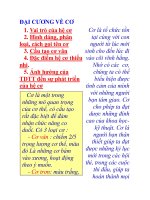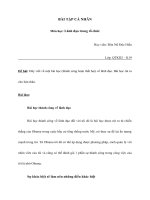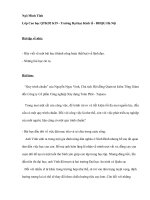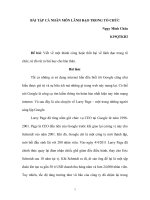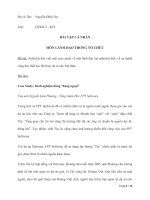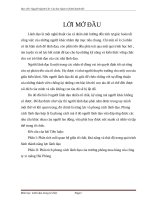Slide đại cương về lãnh đạo trong tổ chức chapter 4 team leadership
Bạn đang xem bản rút gọn của tài liệu. Xem và tải ngay bản đầy đủ của tài liệu tại đây (8.97 MB, 45 trang )
LEADERSHIP:
ng
.c
om
Theory, Application, Skill
Development
co
2d Edition
ng
th
an
Robert N. Lussier
and Christopher F. Achua
du
o
This presentation edited and enhanced by:
cu
u
George W. Crawford
Asst. Prof. of Mgmt.
Clayton College & State University
Morrow, GA 30260
Copyright ©2004 by South-Western,a
division of Thomson Learning. All rights reserved.
CuuDuongThanCong.com
/>
8-1
th
an
co
ng
.c
om
Chapter 8
cu
u
du
o
ng
Team Leadership
Copyright ©2004 by South-Western,a
division of Thomson Learning. All rights reserved.
CuuDuongThanCong.com
/>
8-2
u
du
o
ng
th
an
co
ng
Group VS Team
Teams pros and cons
6 characteristics of effective teams
3 Types of teams
Team leaders role in supporting creativity
5 determinants of effective team decisions
Leader’s role in group decisions
3 Parts of effective meetings
cu
ã
ã
ã
ã
ã
ã
ã
ã
.c
om
Chapter 8
Learning Outcomes
Copyright â2004 by South-Western,a
division of Thomson Learning. All rights reserved.
CuuDuongThanCong.com
/>
8-3
Group VS Team
TEAM
.c
om
GROUP
–Shared mission
–Varies values
ng
–Collective responsibility
co
–Commitment varies
an
–More independent
–Strong commitment
th
VS–Common goals or tasks
ng
–Strong leader
cu
u
du
o
–Individual
accountability
–Shared leadership roles
–Individual and mutual
accountability
–Equality
–Good for the whole
Copyright ©2004 by South-Western,a
division of Thomson Learning. All rights reserved.
CuuDuongThanCong.com
/>
8-4
ng
.c
om
TEAM
cu
u
du
o
ng
th
an
co
T = Together
E = Everyone
A = Accomplishes
M = More
Copyright ©2004 by South-Western,a
division of Thomson Learning. All rights reserved.
CuuDuongThanCong.com
/>
8-5
cu
u
du
o
ng
th
an
co
ng
.c
om
No matter what you
are trying to do,
TEAMS are the most
effective way to get
the job done.
Copyright ©2004 by South-Western,a
division of Thomson Learning. All rights reserved.
CuuDuongThanCong.com
/>
8-6
.c
om
Teamwork
ADVANTAGES
DISADVANTAGES
an
th
–Faster, better decisions
co
–Avoids major errors
du
o
ng
–Continuous improvement
–Innovation
u
–Stimulates self-motivation
cu
–Pressure to conform to
group standards
and conduct
ng
–Synergy
–Greater job satisfaction
–Ostracized for
productivity
–Social loafing
–Groupthink
–Inter-group conflicts
–Needs fulfillment
Copyright ©2004 by South-Western,a
division of Thomson Learning. All rights reserved.
CuuDuongThanCong.com
/>
8-7
9 Team Leader’s Roles
in creating effective teams
.c
om
1. Emphasize group recognition and rewards.
2. Identify and build on team’s strengths.
ng
3. Develop trust and a norm of teamwork.
an
co
4. Develop team’s capabilities to anticipate and deal with
change.
ng
th
5. Empower teams to accomplish work with minimal
interference.
u
du
o
6. Inspire and motivate team toward higher levels of
performance.
cu
7. Recognize individual and team needs and timely attend to
them.
8. Encourage and support team decisions.
9. Provide team with challenging and motivating work.
Copyright ©2004 by South-Western,a
division of Thomson Learning. All rights reserved.
CuuDuongThanCong.com
/>
8-8
.c
om
9 Organizations’ Roles
in creating effective teams
1. Top management’s unconditional support.
co
3. Flexible task structure.
ng
2. Adequate information and other resources.
th
an
4. Appropriate size and membership mix.
ng
5. Clearly defined mission statement and goals.
u
du
o
6. Appropriate power sharing structure - shared
leadership.
cu
7. Competent team leadership.
8. Evaluation and solicitation of feedback on team
effectiveness.
9. Adequate socialization of team members.
Copyright ©2004 by South-Western,a
division of Thomson Learning. All rights reserved.
CuuDuongThanCong.com
/>
8-9
Post Activity Reviews and
Dialogue Sessions
.c
om
facilitate team learning by:
th
an
co
ng
1. Analyzing reasons for success
or failure.
cu
u
du
o
ng
2. Reviewing what went well &
what can be improved.
3. Discuss perceptions & assumptions.
Copyright ©2004 by South-Western,a
division of Thomson Learning. All rights reserved.
CuuDuongThanCong.com
/>
8-10
Need for
Traditional
co
ng
Leadership
th
an
Cross-functional
Team
ng
du
o
cu
u
Types
of
Teams
.c
om
Functional
Team
Self-managed
Team
Need for
Team
Leadership
Copyright ©2004 by South-Western,a
division of Thomson Learning. All rights reserved.
CuuDuongThanCong.com
/>
8-11
.c
om
Functional Teams
cu
u
du
o
ng
th
an
co
ng
• Sometimes referred to as
Problem Solving Teams
• Groups of a line manager and 5
to 12 employees, all from the
same department, who meet for
a few hours each week to
discuss ways of improving
quality, efficiency, and the
work environment.
Copyright ©2004 by South-Western,a
division of Thomson Learning. All rights reserved.
CuuDuongThanCong.com
/>
8-12
.c
om
Cross-Functional Teams
cu
u
du
o
ng
th
an
co
ng
• Employees from about the
same hierarchical level, but
from different work areas,
who come together to
accomplish a task or project
• Some members can be from
outside the organization
Copyright ©2004 by South-Western,a
division of Thomson Learning. All rights reserved.
CuuDuongThanCong.com
/>
8-13
.c
om
Self-Managed Teams
cu
u
du
o
ng
th
an
co
ng
Groups of 10 to 15 people,
from different departments
who take on responsibilities
of their former supervisors
to manage the team and
achieve its goals
Copyright ©2004 by South-Western,a
division of Thomson Learning. All rights reserved.
CuuDuongThanCong.com
/>
8-14
.c
om
Skill Set Required of a
High Performance Team
cu
u
du
o
ng
th
an
co
ng
• Technical expertise
• Problem-solving and
decision-making skills
ã Interpersonal skills
Copyright â2004 by South-Western,a
division of Thomson Learning. All rights reserved.
CuuDuongThanCong.com
/>
8-15
Team Creativity
cu
u
du
o
ng
th
an
co
ng
.c
om
• The process of generating new
ideas, products, processes, or
services
• The creation of valuable, useful
new products, services, ideas,
procedures, or processes by
individuals working together in a
complex social system
Copyright ©2004 by South-Western,a
division of Thomson Learning. All rights reserved.
CuuDuongThanCong.com
/>
8-16
Team Creativity
.c
om
• High use of creativity
cu
u
du
o
ng
th
an
co
ng
– More valuable than great
financial resource
– Organizations survive and
thrive
– Important for Self-Managed
Teams
Copyright ©2004 by South-Western,a
division of Thomson Learning. All rights reserved.
CuuDuongThanCong.com
/>
8-17
Recognition
&Reward
.c
om
Adequate
resources
th
an
co
ng
4
Organizational
Practices that
Support
Team Creativity
du
o
ng
by providing teams:
cu
u
Support
climate
and culture
Copyright ©2004 by South-Western,a
division of Thomson Learning. All rights reserved.
CuuDuongThanCong.com
Flexibility
/>
8-18
.c
om
ng
th
an
co
Autonomy for members
cu
u
du
o
ng
Four
Team Leader
Practices
That
Support
Creativity
Members matched
Protection against
“Creativity Blockers”
Adequate time & money
Copyright ©2004 by South-Western,a
division of Thomson Learning. All rights reserved.
CuuDuongThanCong.com
/>
8-19
Blocks to Creativity
• Functional fixedness
.c
om
– One one way to do something
an
co
ng
• Lack of technical expertise
• High levels of technical expertise &
experience
th
– Can lead to relying on past solutions
du
o
ng
• Evaluation of ideas
cu
u
– Creative people don’t like to have their
ideas and creations evaluated
ã Extrinsic motivators
ã Lack of autonomy & control
Copyright â2004 by South-Western,a
division of Thomson Learning. All rights reserved.
CuuDuongThanCong.com
/>
8-20
Steps to Improve
Creativity
ng
.c
om
• Brainstorming
• Analogies
co
– Seeing one thing as something else
th
an
• Encouragement by leaders
du
o
ng
– Reward success
– Never punish failure
cu
u
• Form diverse problem-solving groups
• Ensure the proper level of technical
expertise in problem-solving groups
Copyright ©2004 by South-Western,a
division of Thomson Learning. All rights reserved.
CuuDuongThanCong.com
/>
8-21
How to Lead
Creative Followers
.c
om
• Set goals
– Use high participation in goal setting
an
co
ng
• Provide adequate resources
• Reduce time pressures
th
– But keep followers on track
du
o
ng
• Consider nonmonetary as well as
monetary rewards
cu
u
– Monetary rewards can be seen as
“controlling”
• Recognize that creativity is
evolutionary, not revolutionary
Copyright ©2004 by South-Western,a
division of Thomson Learning. All rights reserved.
CuuDuongThanCong.com
/>
8-22
.c
om
Team Decision Making
cu
u
du
o
ng
th
– Take longer
– Not necessarily better
– May be:
co
an
– Improved quality
– Diffusion of
Responsibility
– Better understanding
– Higher commitment
ng
• Disadvantages
• Advantages
• Self serving
ã Contrary to
organizations best
interest
ã Team defensive
response
Copyright â2004 by South-Western,a
division of Thomson Learning. All rights reserved.
CuuDuongThanCong.com
/>
8-23
th
Member’s
Status
ng
du
o
Team Size
and
Composition
an
co
ng
.c
om
5 Determinants
of Effective
Team Decisions
cu
u
Member’s
Traits and
Values
Team
Cohesiveness
Quality
of
Leadership
Copyright ©2004 by South-Western,a
division of Thomson Learning. All rights reserved.
CuuDuongThanCong.com
/>
8-24
.c
om
Leader’s Role in
Group Discussions
ng
• Traditional Approach
cu
u
du
o
ng
th
an
co
– Focus on task
– Ignore personal feeling
– Seek opinions
– Get agreement
– Make final decisions
Copyright ©2004 by South-Western,a
division of Thomson Learning. All rights reserved.
CuuDuongThanCong.com
/>
8-25
